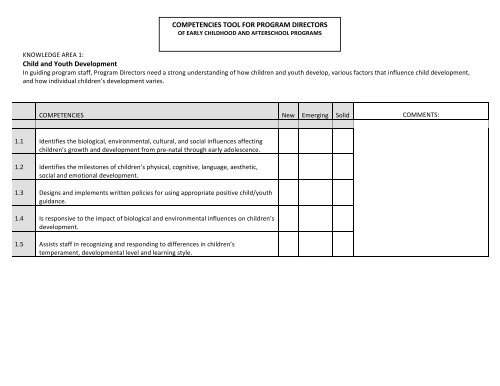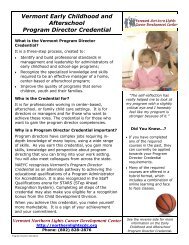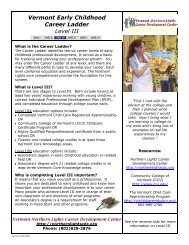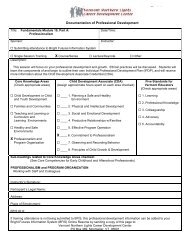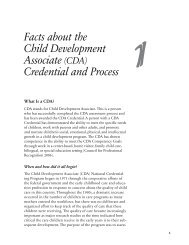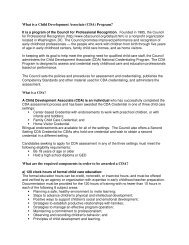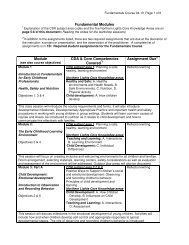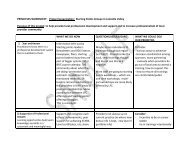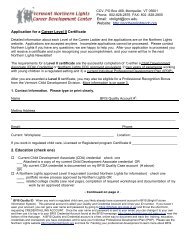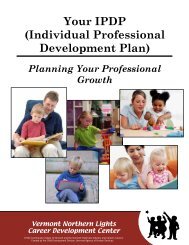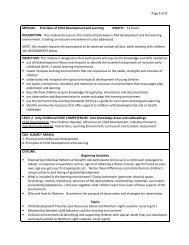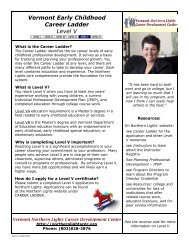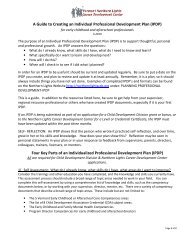Program Director Self-Assessment Tool - Vermont Northern Lights ...
Program Director Self-Assessment Tool - Vermont Northern Lights ...
Program Director Self-Assessment Tool - Vermont Northern Lights ...
Create successful ePaper yourself
Turn your PDF publications into a flip-book with our unique Google optimized e-Paper software.
COMPETENCIES TOOL FOR PROGRAM DIRECTORSOF EARLY CHILDHOOD AND AFTERSCHOOL PROGRAMSKNOWLEDGE AREA 1:Child and Youth DevelopmentIn guiding program staff, <strong>Program</strong> <strong>Director</strong>s need a strong understanding of how children and youth develop, various factors that influence child development,and how individual children’s development varies.COMPETENCIES New Emerging Solid COMMENTS:1.1 Identifies the biological, environmental, cultural, and social influences affectingchildren’s growth and development from pre‐natal through early adolescence.1.2 Identifies the milestones of children’s physical, cognitive, language, aesthetic,social and emotional development.1.3 Designs and implements written policies for using appropriate positive child/youthguidance.1.4 Is responsive to the impact of biological and environmental influences on children’sdevelopment.1.5 Assists staff in recognizing and responding to differences in children’stemperament, developmental level and learning style.
KNOWLEDGE AREA 2:Families and Communities<strong>Program</strong>s need partnerships with families and with members of the community. <strong>Director</strong>s must know their families, advocate on their behalf, and build alliancesto ensure that children and families have the opportunities they need to be successful.COMPETENCIES New Emerging Solid COMMENTS:2.1Identifies community services available to children and families, includingeducation, health, mental health, nutrition, social services, and familysupport and can assist families in accessing these services.2.2 Develops collaborations with agencies and community resources to meetthe needs of children and families.2.3 Maintains oversight of consultants, specialists, and community teamsworking on behalf of enrolled children and families.2.4 Provides comprehensive services that incorporate the cultural diversity ofthe community.2.5 Designs and use multiple strategies to involve families in the program.2.6 Explores key issues, barriers, and resources for working with families andlocal schools to develop school readiness and transition strategies.2.7 Models effective communication techniques and selects appropriatemethods to build trusting relationships with children, staff and families.2.8 Implements administrative practices that promote the inclusion ofchildren with special needs.*<strong>Vermont</strong> 2‐1‐1 is a simple number to dial for information about health and human service organizations in your community. It is a local call from anywhere inVT, and is available during business hours. The website http://www.vermont211.org/ is available 24/7.
KNOWLEDGE AREA 3:Teaching and Learning / Curriculum and Learning Environments<strong>Director</strong>s must implement and sustain a culturally sensitive, non‐discriminatory and inclusive learning environment based on principles of child and youthdevelopment and professional standards.3.13.2COMPETENCIES New Emerging Solid COMMENTS:Selects and implements curriculum based on principles of childdevelopment, best practices, and early learning and afterschoolstandards.Evaluates the implementation of curriculum by staff and volunteers.3.3 Selects appropriate informal and formal child/youth assessments andguides staff in their use.3.4 Uses child/youth assessments to guide and inform curriculumimplementation.3.5Plans and evaluates indoor and outdoor learning environments.3.6 Manages the purchase and maintenance of supplies, materials, andequipment.3.7 Establishes and maintains learning environments that are responsive toand meets the needs of children at different ages and developmentallevels.
KNOWLEDGE AREA 4:Healthy and Safe EnvironmentsKeeping children and staff safe and healthy is a fundamental requirement of any facility. <strong>Director</strong>s must ensure that policies designed to promote sound health,safety, nutrition, and exercise practices are effectively implemented.COMPETENCIES New Emerging Solid COMMENTS:4.1 Evaluates the facility and equipment for meeting county, state, andnational standards of health and safety.4.2 Adheres to health and safety requirements and maintains necessaryrecords as defined by state codes and regulations for children and staff.4.3 Develops and implement written policies and procedures to ensure ahealthy and safe environment for children and staff.Develops and implements an emergency preparedness plan to include4.4 policies and procedures that address staff training, maintenance ofemergency supplies and equipment, and the continuation of services.4.5 Develops procedures to ensure that state and federally mandated ChildAbuse and Neglect regulations are followed.4.6 Assures that food served by the program provides variety and complieswith nutritional standards and regulations.4.7 Plans and monitors a system for sanitary preparation and food service incompliance with all health regulations.4.8 Plans and monitors a system to ensure regular physical activity for allchildren.
KNOWLEDGE AREA 5:Professionalism and <strong>Program</strong> Organization<strong>Director</strong>s need a solid foundation in the principles of organizational management, including how to establish systems for smooth program functioning and howto manage staff to carry out the mission of the program.COMPETENCIES New Emerging Solid COMMENTS:A. ProfessionalismCreates an inclusive, bias‐free, and diverse environment that values5A.1 respect, reflective thinking and an open exchange of professionalideas.Establishes and follows effective communication and decision‐making5A.2 structures with program staff and stakeholders.Employs effective skills in group process, team building, and conflict5A.3 resolution.Conducts ongoing program evaluations and includes input from5A.4 families and staff.Develops a strategic plan for the program and implements goals and5A.5 objectives into daily practice.Models and integrates the national code of ethical conduct into5A.6 policies and practices.Uses safe and effective technology for communications and program5A.7 management.Develops effective marketing strategies and materials using a variety5A.8 of media.Seeks out and engages in ongoing professional development and5A.9 learning.
B. Fiscal Management New Emerging Solid COMMENTS:5B.1 Develops written fiscal policies and procedures following generallyaccepted business practices and basic accounting principles and assurescompliance with applicable guidelines.5B.2 Develops and operates within a balanced budget.Prepares and presents budget and business reports to appropriate5B.3 entities.Applies concepts of budgetary projection, including enrollment, tuition5B.4 and late fee policies.5B.5 Develops a compensation structure and manages payroll.Manages the purchase and maintenance of supplies, materials, and5B.6 equipment.5B.7 Manages county, state, and federal reimbursement funds.Identifies available financial resources at federal, state, and regional5B.8 levels.Engages in effective grant writing, grant management, and fiscal5B.9 evaluation.Develops and implements a fundraising plan driven by program needs5B.10 and philosophy.
C. Legal Issues New Emerging Solid COMMENTS:5C.1Adheres to all applicable federal, state, and county laws, codes, andregulations as they relate to: family law; child custody; confidentiality;child neglect and abuse; non‐discriminatory practices; classroom ratiosand class size; labor laws, Americans with Disabilities Act; OccupationalSafety and Health Administration; IDEA, etc.5C.2 Complies with program policy, liability, and licensing regulations.5C.3 Implements strategies for working cooperatively with regulatoryagencies.D. Personnel New Emerging Solid COMMENTS:5D.1Develops and implements written personnel policies that comply withapplicable laws and regulations and align with best practices.5D.3Develops and maintains staffing patterns that provide consistency andcontinuity of care.5D.4 Develops a system to manage and maintain personnel records.Writes effective job descriptions using core competencies and uses these5D.5 in recruiting, hiring, supervising, and evaluating personnel.Creates a positive and proactive work environment that supports staff5D.6 and volunteers.Implements policies and procedures for recruiting, hiring, evaluating,5D.7 and terminating staff.Engages staff in developing and supporting the program’s mission and5D.8 philosophy.Provides program orientation and ongoing professional development5D.9 opportunities for staff and volunteers.
E. LeadershipArticulates the program’s vision, mission, and values, and create a5E.1 culture built on norms of diversity, continuous improvement, and ethicalconduct.Defines problems, gathers data to inform decisions, and applies5E.2 necessary skills to solve problems.Engages in self‐assessment, sets personal and professional goals, and5E.3 models lifelong learning.Participates in professional organizations at the local, state and national5E.4 level.Demonstrates leadership in self‐selected initiatives at the local, state5E.5 and national level.Expands sphere of influence to bring needed change to the program, the5E.6 community, and the profession.Implements strategies to influence public policy on behalf of5E.7 children/youth and families.New Emerging SolidCOMMENTS:


